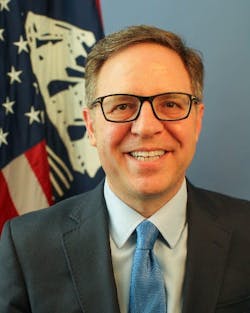NTIA emphasizes fiber broadband focus but leaves room for alternative technologies
Nashville, Tennesee-As providers look to take advantage of the Broadband Equity and Broadband Equity, Access, and Deployment (BEAD), the emphasis is on developing fiber-based broadband deployments.
Alan Davidson, assistant secretary of Commerce for Communications and Information and NTIA administrator, addressed rumors that the organization would abandon the fiber preference for BEAD deployments.
The BEAD program is a $42.5 billion state block grant that helps create universal broadband coverage by subgranting entities to build broadband infrastructure in unserved and underserved areas.
“The administration has an ambitious mission to connect everyone with reliable and affordable high-speed internet service,” he said. "Nothing has changed in the focus of our mission, and we are fiber-focused.”
Since the BEAD program represents a once-in-a-lifetime initiative, the focus should be on long-term methods.
“We won’t get the opportunity to do this again. We will not get tens of millions of dollars to build internet infrastructure again,” Davidson said. “The potential to build networks that will stand the test of time and will be future proof, we believe in most places, will be fiber.”
He added that there would be places where “it is very difficult or expensive to reach, so there are other technologies we can use, which will vary from state to state.”
Alternative technology guidance
NTIA’s BEAD program has a cascade of technologies to consider.
This list starts with an emphasis on fiber-based projects.
“Fiber projects get priority,” Davidson said. “We know there will be some circumstances where fiber build-outs won’t be in a particular area, and states can rely on licensed wireless deployments.”
Other states could consider other technologies using unlicensed wireless spectrum or Low Earth Satellite (LEO).
“We know that in some states, these technologies will make the most economic sense,” Davidson said. “We’re going to put out a guideline document outlining how to use these alternative technologies.”
However, he did not specify a timeline for implementing the new guidance. “The document is coming shortly, and it will be open for public comment,” Davidson said.
State approvals accelerate
NTIA has seen the approval of BEAD funding allocations for various states acclerate in recent months.
To date, the NTIA has approved proposals from 26 states.
BEAD-eligible entities—the 56 states, territories, and the District of Columbia—must submit an Initial Proposal detailing how they plan to spend their BEAD allocation to deliver high-speed Internet access to all unserved and underserved locations within their borders for NTIA's approval.
All states submitted their Initial Proposals by December 27, 2023.
The NTIA needed the initial plans from the states to understand how the funds would be used to build broadband networks.
“Before we can write a big check and know how a state will spend the money, we need to see a plan,” Davidson said. "We have been reviewing those plans, and 26 have been announced.”
This past week, NITA approved several state proposals, including Missouri, Montana, New Mexico, Oklahoma, Tennessee, Vermont, and Virginia.
Davidson said that the agency will pick up the pace in the coming months on the approval process.
“You are going to see a steady increase in our cadence,” he said. "This will continue through the end of the summer as we finish approving these plans. The secretary of commerce will authorize all of the state's proposals by the fall.”
He added, “States are ready and are not slowing down, and challenging processes are underway now.”
While it is unclear how whoever wins the election in November could change the outcome of BEAD, Davidson emphasized that it and other programs have the bipartisan support of Republicans and Democrats.
“Our plans are part of a bipartisan infrastructure law,” he said. “Everywhere I go in this country, people are excited about getting better internet service, and people on both sides of the aisle care about the future of these programs.”
Driving digital equity
Besides building the infrastructure to connect more homes and businesses, NTIA is also focusing on how to access the internet with devices and necessary digital skills.
“This is not just a story about access because our ultimate goal is for people to thrive online,” Davidson said. “It starts with access, but affordability is important. Do people have the skills to know what to do when they get online?”
NTIA’s funding is designed to create digital equity programs to reach communities left behind, including the elderly, disabled, minorities, and rural communities.
The agency has two programs.
Every state and territory has a digital equity plan for the first time. This spring, NTIA launched an $800 million state grant program to fund these plans.
Recently, NTIA made nearly $1 billion available to fund programs that ensure communities have access to devices and skills needed to fully participate in the digital world, regardless of their background or circumstances.
The Notice of Funding Opportunity (NOFO) released allows various organizations to apply for funding on a competitive basis.
Proof of these programs is being seen in cities like Pittsburgh. The city has created coding buses for community organizations and senior centers to teach people how to code and get online.
“This kind of work on the ground will make digital literary happen,” Davidson said.
Ramping the workforce
Another critical issue to consider when the BEAD funding is allocated to build out broadband is making sure there is a workforce to build the networks.
According to the Fiber Broadband Association's research, it will take about 78,000 fiber technicians to support the forthcoming infrastructure.
While FBA launched its OpTIC Path program to train new technicians, procuring new talent has been difficult.
Davidson recognized that BEAD is also a mechanism for creating new jobs. “The good news is BEAD is not just a connectivity program; it’s also a jobs and manufacturing program,” he said.
The NTIA has encouraged states to dedicate money to workforce training.
States are stepping up. Minnesota has partnered with local service providers to offer childcare, while Wisconsin, Louisiana, and Georgia state tech colleges have come together to provide fiber optic training programs.
“There are many examples of how people are tackling the workforce problem on the ground,” Davidson said. "We need to find what is working, promote it, lift it up, and try to provide funding for it.”
For related articles, visit the Broadband Topic Center.
For more information on high-speed transmission systems and suppliers, visit the Lightwave Buyer’s Guide.
To stay abreast of fiber network deployments, subscribe to Lightwave’s Service Providers and Datacom/Data Center newsletters.

Sean Buckley
Sean is responsible for establishing and executing the editorial strategies of Lightwave and Broadband Technology Report across their websites, email newsletters, events, and other information products.


